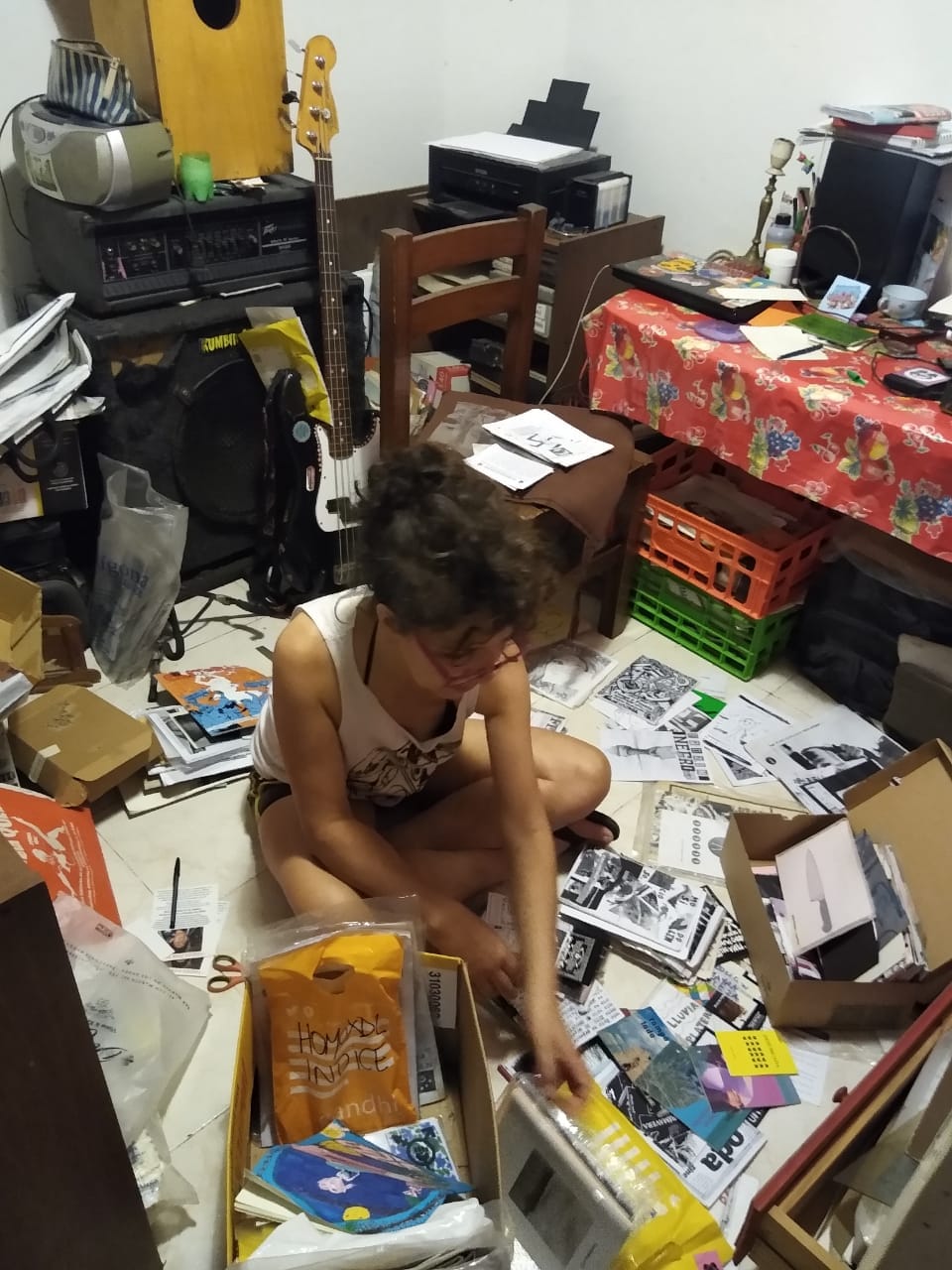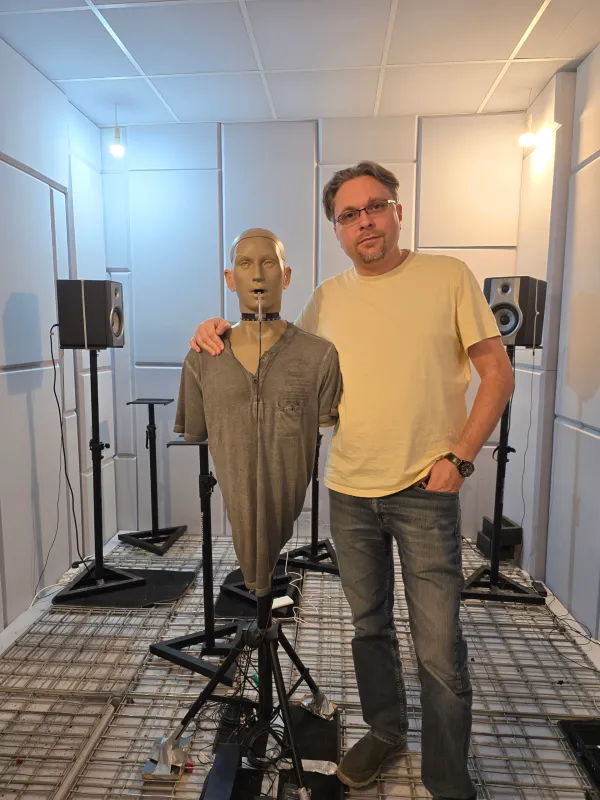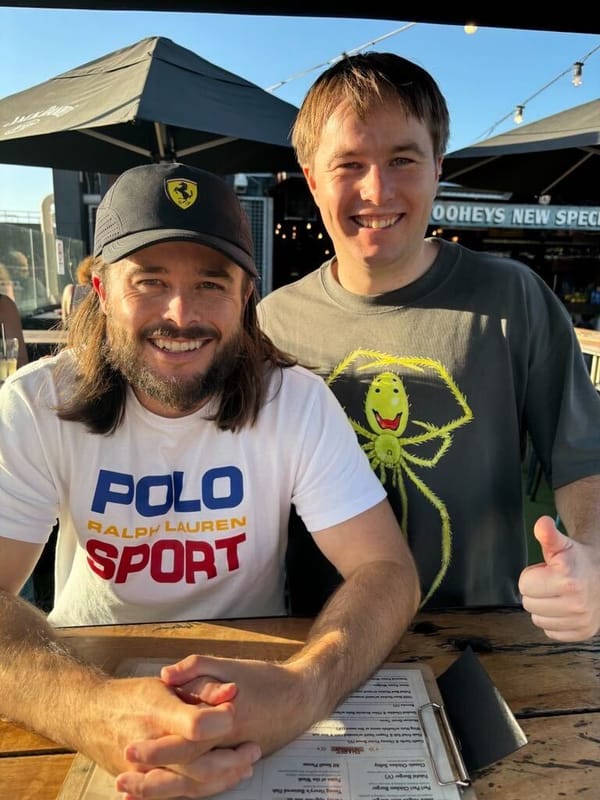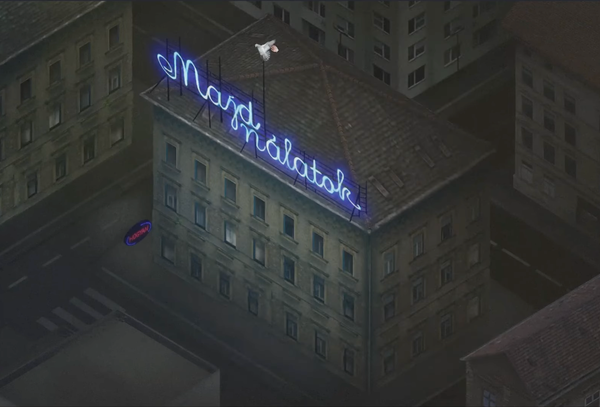In this series, Argentina-based curator, researcher and sound artist Florencia Curci introduces us to artists and creators who, through their diverse activities, bring communities together to educate, create and express themselves within the cultural and political landscape of South America. Drawing from this intensive engagement with sound and archival practices, Florencia researches tools for community-building. These gatherings act as nests of friendship that give rise to actions that build foundations for better futures, resisting the monoculture of the present.
Trigger Warning: This interview contains explicit language that some may find offensive or disturbing.
Printed registers of underground culture in Argentina’s post-dictatorship. Talk with Patricia Pietrafesa
Pat Pietrafesa is a pioneer of the punk movement in Argentina. She edited the fanzine Resistencia (1984-2001), which documents not only the punk movement in Buenos Aires – and around the world – but also a scene of rebellion of which she herself was a part and an agitator. She played in bands such as Sentimiento Incontrolable and Cadáveres de Niños, and currently with She Devils and Kumbia Queers. Her publishing house Alcohol y Fotocopias has just marked its tenth anniversary. Since 2012, she has organised the Feria del Libro Punk y Derivados / Punk and Derivatives Book Fair.
In 2020, when I was involved in the curatorship of an exhibition at the Centro de Arte Sonoro about the relationship between graphics and sound arts, I contacted Patricia to produce a small “digital fanzine” to distribute during the lockdowns. As a result of this, she offered a graphic tour using scraps of paper that follow the traces of urgent messages captured on photocopies and calls to engage in agitation at small events of high intensity that, in the period after the last military dictatorship, emerged as small sparks that ignited nonconformism.
In this talk, we will rescue some of those printed samples of fragile preservation, emergency strategies that enabled necessary relationships at key moments, assembling a scene that represents and recognises itself, engaging in dialogues and evolving on the basis of its own means of communication and diffusion.
Florencia Curci: These graphics that we’re going to talk about today are in the archive that you have at home, which consists of an infinite number of fanzines, posters, flyers, records of the Argentine underground scene (and more). How did you build up this archive?
Patricia Pietrafesa: I always work with my archives, which are things I found on the street: a flyer I made, a flyer someone gave me, a fanzine I kept. I have material from 1982 onwards. I don’t keep everything, but I have my own curatorship, which is the set of decisions that led me to keep a certain paper that called for an event that seemed important to me at the time. It was always a love for that kind of graphics, a declared love. Then many people, over time, gave me original fanzines, their photos, knowing that in their hands they were at risk or they no longer knew where or why to keep them. Sometimes it happens that people lose interest in something they did long ago when they were 18 years old, so I’ve preserved everything that they gave me and taken care of it as the most precious thing I have.
FC: It’s a very personal archive that must have some component of chance. I like to think that an archive is not only the subjectivity of hegemony, which would be institutional archives, but also personal archives can have these levels of openness and valorisation at different times.
PP: That’s also what the Archivo de Culturas Subterráneas / Archive of Subterranean Cultures is about, and I say this as an incentive. When I say that everything I have in my archive are things that are impacted by my own experience, I don’t say this as something personalistic but to emphasise that each person has their own archives of a period of their life, of a place where they lived, of their family. And that’s how different archives can be formed that show different points of view of history. They are all those cracks that we’re constantly opening in the supposed “hegemonic history” (a history that cannot be touched or which was supposed to happen in a single straight line and there’s an institutional archive to prove it). On the contrary, the fragility of the archives we handle shows that all history can also be an invention.
FC: How did you select the materials for the publication you made for Emergence y Nostalgia. Graphs and graphics in Sound Experimentation?
PP: I chose some events or historical moments that happened in the post-dictatorship period. A period in which I began to move into the subterranean scene, first in punk and then in some places close to punk, but always in the subterranean. The subterranean is a place where it seems to me that interesting things happen, things that always have a mystery about them, that you always have to dig to understand them or dig to get to them, probably in some kind of dive.
That was attractive to me, and it’s something I still feel to this day. Events that take place in what some historians call “the dustbin of history”, “the backyard”, in short, where you can rummage and scratch at a lot of small events that perhaps reach us in an unthinkable way: in a flyer, in a book, a note in a fanzine that you found in someone’s house and read, something that had an impact on you. These events are totally unknown to the vast majority, and I rescued them as best I could. I always wonder why I rescued some and not others. Others are still in the shadows of my archive. In the time I have, I will continue to bring these small events to light.
FC: I think this is a very interesting question, and I daresay that surely there’s a resonance with the present that makes some materials stand out from others. They have a particular brightness depending on the light of the historical moment in which you go back to an archive.
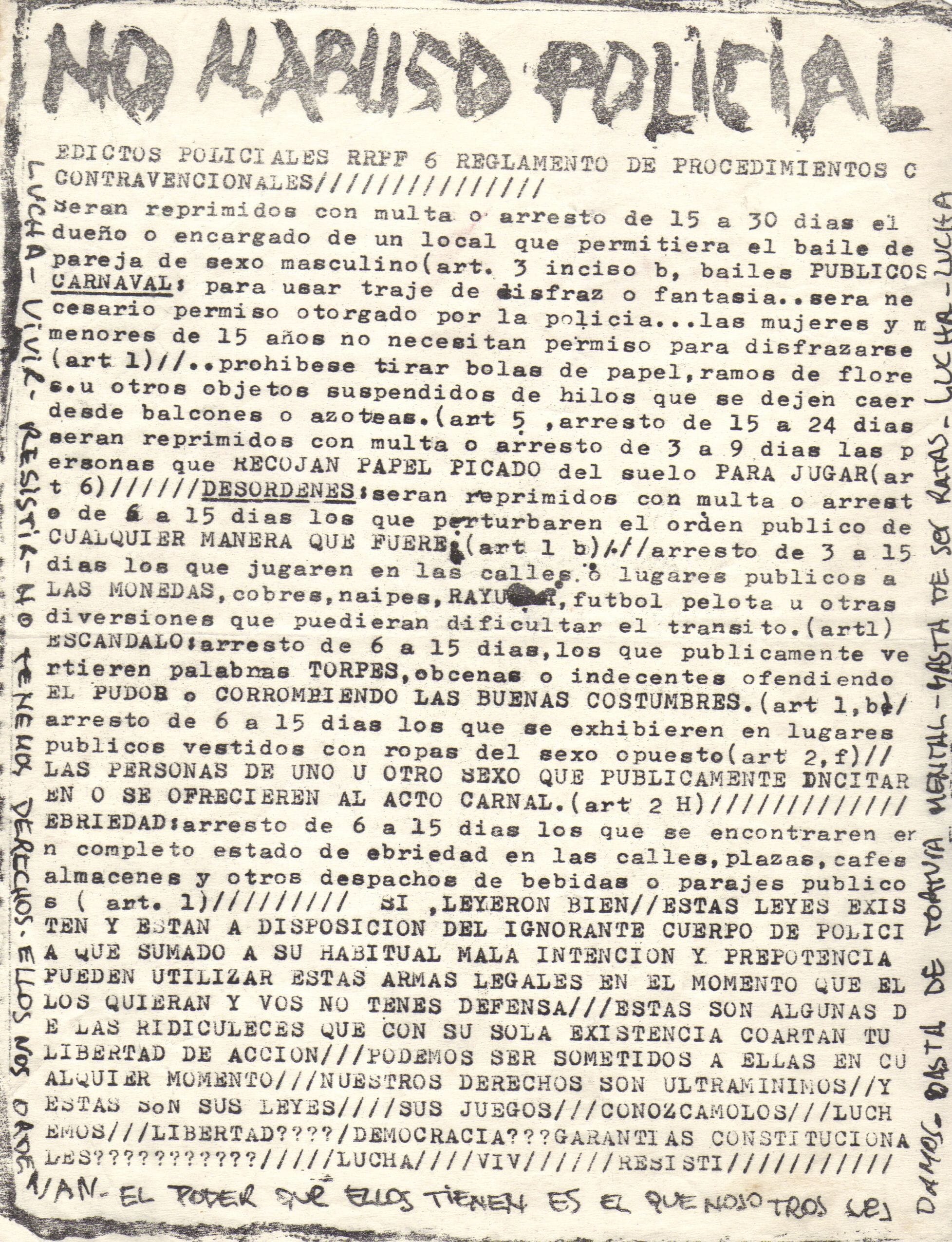
PP: Yes! And as a first moment, I chose an event that happened on 4 July 1985: the first demonstration against police edicts (contempt of court or “desacato a la autoridad” was the name of one of these). It was a very important event attended by very few people. It’s a flyer made with carbon paper. Something that was also very popular at that time was to recycle flyers. We used all the old flyers we found on the street cut and written on carbon paper mentioning this meeting on Entre Rios Avenue and Rivadavia (in front of the Congress in Buenos Aires).
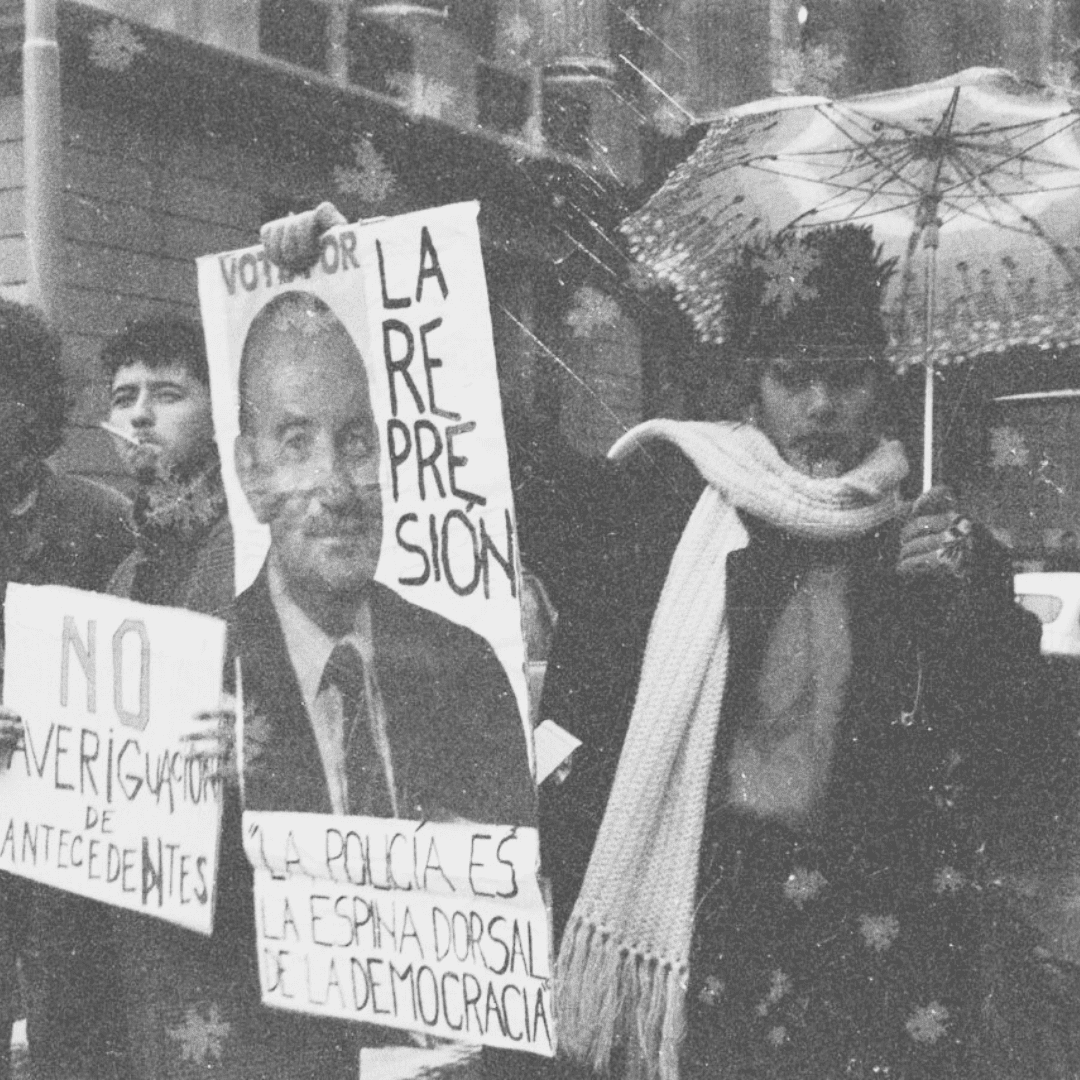
The funny thing is that it was a rainy day. It was winter and there weren’t many people. We were about 20 or 25 people. The event was organised by the magazine Cerdos y Peces. We had been living in a supposed democracy for two years at that moment, but it was still very evident how the raids and daily persecutions of all kinds of people who did not look like “normal guys” continued. It was something that wasn’t talked about much at that time, although the first human rights organisations were already active and the street raids were not yet visible. We have to take into account that there were, at that time, still police officers who had been working during the dictatorship. It was an extremely difficult transition process, and the police would arrest anyone who was dressed strangely. A cut T-shirt, or to be dressed in black was practically a crime because it meant that you weren’t part of the supposed normality that they would have wanted to have after destroying and annihilating everything (which they had done during the dictatorship). But it turned out that the sewers began to be uncovered and all the people began to walk the streets: sex workers, transvestites, trans people, freaks, gays, queers, lesbians, heavies, goths, punks – we all ended up in jail because of some of the edicts that had been in force since the end of the 19th century.
FC: So the first demonstration against police violence after the dictatorship was called for by a cultural magazine?
PP: In Cerdos y Peces, they had already published some notes of protests on this issue, and that led to the initiative to make this demonstration that was then also called for by the signatories of the flyer: sex professionals, by the CHA *homosexual community of Argentina), the “punk movement”, says the flyer (although I guess it was me, and five other people), and anarchists. The flyer mentions “union of sex professionals”, but in fact, the only one was Ruth Mery Kelly. And well so there were about two people per group. There were also the young Jews for human rights; they were the ones who brought more people.
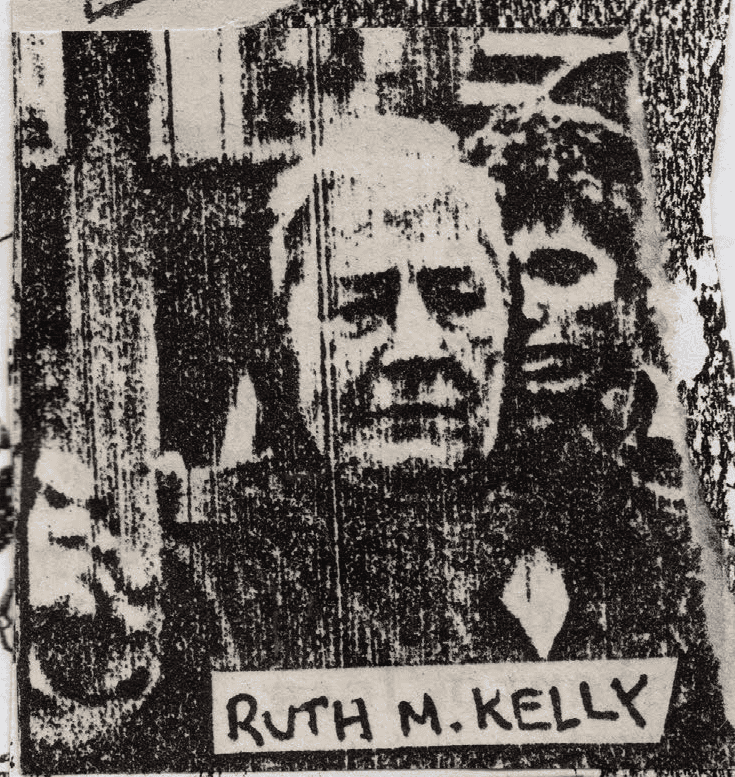
FC: She’s also a prominent figure in the composition of the publication. Why were you especially interested in bringing her?
PP: Ruth was a woman who was in her sixties at that time, and her dream was to create a union of sex workers. But for a moment she was there alone, and she appeared everywhere, claiming to be the legal figure of the union of sex professionals. The interesting thing was that, at that meeting, which was attended by very few people, Ruth Mery Kelly’s role was very important since she was the one who proposed the method of blocking off traffic from the street, for the first time. Everybody was a little bit afraid, but we followed her. I take that event because I consider it very valuable as it was the beginning of other protests that drew attention to a set of ridiculous and violent rules. There were several demonstrations over the course of two years. This was the first one, and it was the antecedent to this very rare connection between all these diverse people who populated the post-dictatorship. Where there was so much to protest about, you had to go to that demonstration but also, for example, to the pagan marches to ask for the right to divorce (when you didn’t even agree with the marriage, but well, we had to ask for divorce) and a lot of other things.
FC: Is it difficult to preserve these papers made with carbon paper ink?
PP: I found it less difficult to preserve than many other things that are photocopies and are evaporating because of the poor quality of the toner. A badly photocopied fanzine from the mid-1980s is already disappearing. The most terrible thing is that, in the last few years, it has become more and more diluted. Every time I take it out, I see that it’s fainter and fainter. Now I’m working to recover some fanzines, but others have been lost. For example, the file I keep of the petition that Ruth Mery Kelly herself wrote on a typewriter and photocopied. I have the photocopy, but one side of the sheet has disappeared. Only the back side where the signatories are listed is there, but the petition has disappeared. That’s the precariousness of our archives – the photocopy of the original, which also shows the precariousness that existed at that time.
FC: Many years have passed and the materiality of these pieces is a consequence of being produced in a moment of emergency, to be used at that moment. It’s not material that’s born with an archival consciousness either. They’re becoming relics now, because of the distance or because of how history developed afterwards.
PP: Exactly, it didn’t matter if that paper existed beyond June 1985. It was made to give it to someone and pass on the information. Now, for me, it’s a bit strange to see this kind of flyer imprisoned in a book. To top it off, there’s an epigraph in the book that claims that I’m “the designer”. I didn’t design it. I wrote an urgent message. Okay, the book, the re-edition, is a way of preserving it, but I disagree with the categories. “Design”, for example. You have to look for other words, or maybe you can explain that the flyer wasn’t a design but an urgent message that was really written for someone to see it.
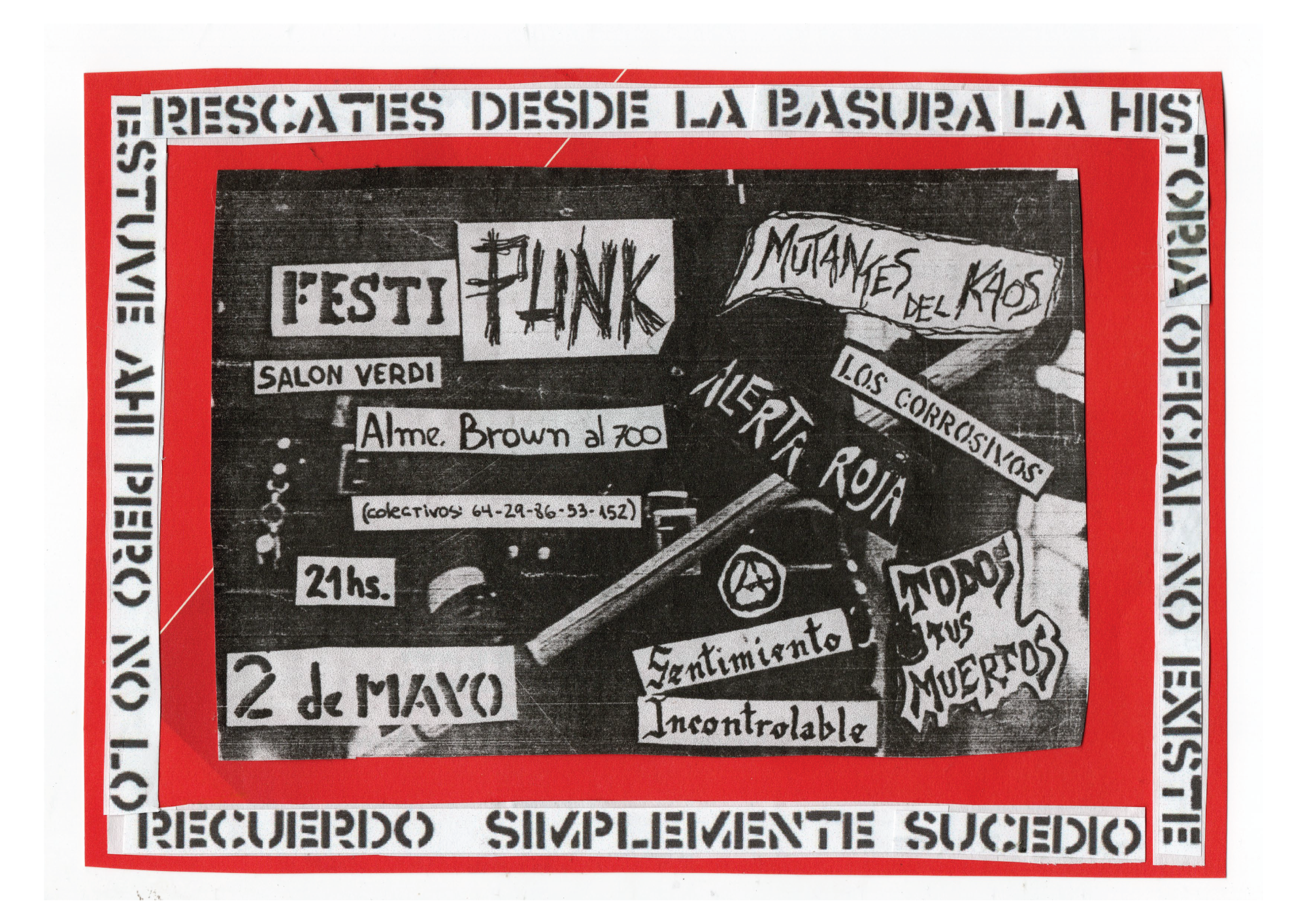
PP: I’d like to mention another event the following year on 2 May 1986. This is the flyer advertising the event, which is the first festival of a cooperative that was put together between several punk bands in that year, in early 1986. The bands were Todos tus Muertos, Sentimiento Incontrolable, Mutantes del Kaos and some other bands. We formed a cooperative of punk bands to organise our own shows and practice what we had read about called “autogestión”. That day was very important because many things happened: we rented the Verdi Hall in the neighbourhood of La Boca (Buenos Aires). The condition was that all the bands had to be in charge of doing absolutely everything: the bar, the technical work, the communication. It was also the first time that a fanzine stand was included at our festivals. There were four or five fanzines including the newspaper of the Mothers of Plaza de Mayo and the anarchist newspapers “La Protesta” and “La Antorcha”.
There were a lot of expectations that day, and obviously, everything could go wrong. What actually went wrong was the arrival of a group of people, of men identified as Boca fans, who wanted to break everything.
FC: Let’s clarify that Boca is the most popular football team from Argentina
PP: It was a Friday night in La Boca, which was full of punks coming from everywhere (something not very common in the mid-80s), so it was terrible. It was a small brawl in which people who self-identified as Boca fans hit everyone at the door, broke into the place, and it was a terrible mess.
A few years ago, I talked to a lot of people who were there. I wanted to reconstruct the event from all points of view. I talked to people who never arrived, who could not arrive, who ended up in the river because they had taken I don’t know what drug. All the people remembered things that no one else recollected (including me), so this event lives in the collective memory, a totally destroyed memory. I was there, but I don’t remember it. It was claimed that the Boca fans had thrown a rock at the guitarist of Exeroica (which was the only girl punk band at that time). That story was always told, but one day I talked to her and she told me that she had never been to that concert. So it’s like a story of an already damaged and very fragile memory, a memory that was already fragile the next day. Imagine what it was like 20 years later. I say this to show the utter fragility of our memories and the reality of shared memories that tell us certain things. The veracity of sources, it’s not just our memories, it’s the memories of others that often construct the official versions of events, build history.
FC: This makes me think about the fragility of oral, or mostly oral, cultures. The transmission of stories that are transformed…
PP: I also reconstructed all of this by making a documentary. Since our history was never documented, there are all kinds of stories.

FC: What was the beginning of fanzines in Argentina? Do you see them as some sort of documentation now?
PP: The first fanzines were Vaselina, Moco and Diarrea Mental (Vaseline, Mucus and Mental diarrhoea), names that represent something that generally causes disgust and revulsion in society (it’s a very punk thing to be trash etc.). Vaselina was the first one since the late 70s in Buenos Aires, Moco since the mid-80s from Mar del Plata (Chary, the singer of Loquero did it) and Diarrea Mental was by Sibil and Gary, the guitarist of Mutantes del Kaos. They were in charge of publicising all of the things that we’re talking about: the festivals of the cooperative, the demonstrations, the activities that the punk scene was doing, and not only punk because it had many points of contact with other things that were happening politically in the underground, like the union for sex workers, punks, whores, lesbians and anarchists that I mentioned. We all took advantage of the spaces that were available to shake everything up and to be present at all the demonstrations, to silk-screen print, to make flyers with whatever we could. It was important to cause a stir. So these media, these fanzines that transmitted this information, had a very small print-run of 20 to 30 copies, which meant that they also had to be passed from hand to hand, and orality was also implied: “I saw this in a fanzine”.
There were very few copies and, well, we didn’t keep the originals either. I have an original of Vaselina, but for the rest we consider original to be the best preserved photocopies.
FC: Why do you think that most originals are lost?
PP: There’s a story that says that they were carrying the originals of Vaselina when a patrol car appeared (when you saw a patrol car, you had to hide and throw away the fanzines or flyers you had on you because they fell under the edicts we were talking about before, as subversive material, printed material that could get you arrested for 30 days). So they threw the originals on top of a newspaper kiosk, and after two days they went to look for them. Those originals were already badly damaged even before they were photocopied. I’ve kept the last issue of Vaseline because someone gave it to me, but not the others. They’re only photocopies that have stood the test of time.
These are the first punk fanzines and, in fact, they are the first fanzines in Argentina. Beyond the fact that the word in the US already referred to publications from the 40s. In Argentina, the publications that came before were called subterranean magazines or had other names, but these are our first fanzines, our history.
FC: These never reached me because of a generational issue, I think, but the one I did follow was Homoxidal…
PP: In the 90s, the hardcore scene started in Argentina with a more “male” aesthetic, with a kind of music that expels women and other identities. Hardcore, I think, is more boy-young-white. I’m interested in rescuing what happened with those who were in punk and hardcore at that time and were faggots, whores or butches. What happened?

The band Fun People did some festivals that they called “hardcore gay anti fascista” just to take out a little bit of the macho that was left over and that was covering everything from the dance venues to stages. I think that by giving that name to festivals there were many of these people who were so macho that they wouldn’t go to a concert that was called gay. That was a very important sieve in the scene and gave a lot of space and airtime to all the people who didn’t have to hide if they were a fag or a lesbian. Then, in the 90s, with the “Homocore” columns by El Profe in the fanzine Resistencia, the whole community that was within the scene started to become visible and exploded in 2001 (again with the energy of the political crisis in Argentina) with the fanzine Homoxidal 500 by Rafael Aladjem (bassist of Restos Fósiles), who told his friends that he was gay directly through the fanzine.
The other fanzine was Drag! by the guitarist of She Devils and Kumbia Queers. She started in 1999, and soon got in touch with Lohana Berkins and María Belén Correa (the Argentine “trabas”). These are examples of the relationships enabled by this kind of media, these fanzines.
It was very nice how the compilation of Homoxidal turned out in a book. It’s very good, but Drag! didn’t allow itself to be trapped in a book. It didn’t want that.
FC: And how do you think these vindications resonate in the present? How are these relationships promoted by the fanzines?
PP: Many of the people who went to those concerts or who read Homoxidal or Drag!, who bought a copy of “el aborto ilegal asesina mi libertad / illegal abortion murders my freedom” (Fun People/She Devils, 1997), are current academics or activists. I met a lot of people through the release of that album who told me “I was 15 years old when I heard it”, and well, those were the main activists in recent years to end up achieving the legalisation of abortion. Most of them name those festivals, those fanzines as their roots.
FC: The first time I read the word “abortion” was in a fanzine.
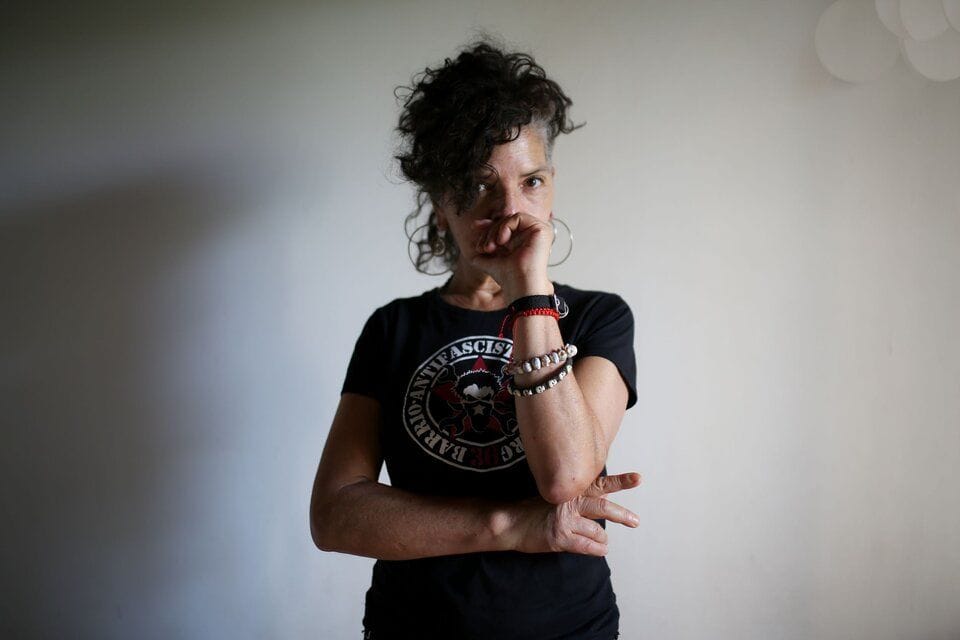
This interview was conducted in Spanish by Florencia Curci. It has been abridged and edited for publishing purposes.
This article is brought to you by 3/4 as part of the EM GUIDE project – an initiative dedicated to empowering independent music magazines and strengthen the underground music scene in Europe. Read more about the project at emgui.de.
Funded by the European Union. Views and opinions expressed are, however, those of the author(s) only and do not necessarily reflect those of the European Union (EU) or the European Education and Culture Executive Agency (EACEA). Neither the EU nor EACEA can be held responsible for them.


